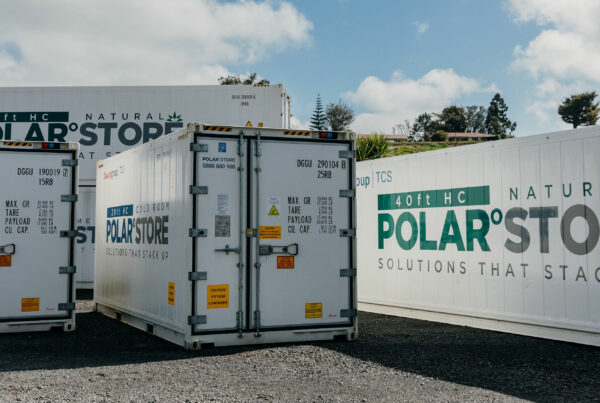Meat is a highly perishable product, which means it requires careful handling and storage to prevent spoilage and maintain its nutritional value. Hence, it is paramount to ensure both quality and safety. New Zealand’s meat industry is a global powerhouse, known for its top-tier quality and sustainable practices. From premium lamb to world-class beef, our meat products are trusted on plates around the world. But this reputation didn’t happen by chance—it’s built on a commitment to excellence every step of the way, from the farm to the fork. And when it comes to keeping that quality intact, cold storage plays a starring role. Using the right cold storage solutions is necessary to make sure products meet safety standards and stay top-notch.
The Importance of Cold Storage for Meat Products
Without the right temperature control, meat is highly susceptible to bacterial growth, which can multiply quickly, leading to potential foodborne illnesses. Cold storage plays a crucial role in slowing bacterial growth by preserving the freshness of the meat, thereby extending its shelf life.
Optimal Temperature Ranges for Meat Storage
Meat must be kept at the right temperature to stay safe and fresh. Fresh meat should be stored between 0°C and 4°C (32°F and 40°F), while frozen meat needs to be kept at -18°C (0°F) or lower. Keeping meat within these temperature ranges helps maintain its quality. For frozen meat, it must stay at the correct temperature the whole time, from storage to transport. Even a small temperature rise can cause it to become warm and refreeze, which can mess with its texture and flavour.
Types of Cold Storage Solutions for the Meat Industry
The meat industry uses different types of cold storage to keep products at the right temperature. These range from small fridges to large, industrial freezers. The bigger the operation, the more advanced the refrigeration systems need to be.
For fresh meat, refrigerated storage units are the most common. These can be small walk-in coolers for smaller businesses or larger cold rooms for bigger operations. These units keep the temperature steady to ensure the meat stays fresh. For frozen meat, freezers or blast freezers are used to freeze the meat quickly and keep it at low temperatures for long-term storage.
Proper Storage Practices: Keeping Meat Safe and Fresh
Storing meat properly isn’t just about keeping it at the right temperature. It’s also about keeping the storage area clean and organised. For example, different types of meat, like beef, chicken, and pork, should be kept in separate areas to avoid cross-contamination. By keeping meat safe and fresh, these practices ensure that every cut, no matter how far it travels, arrives in prime condition. This consistency builds trust with consumers and strengthens relationships with export markets. And it doesn’t stop there—upholding high storage standards also benefits the entire industry, reinforcing our country’s position as a leader in premium meat production.
Air circulation is also important. Good ventilation helps prevent moisture from building up, which can lead to mold and other problems. Some businesses use fans or dehumidifiers to control the moisture levels and keep the storage area in the best condition for the meat.
Frozen Meat Storage: Ensuring Long-Term Quality
When storing frozen meat, the key is to keep it at a steady low temperature to maintain its quality over time. Frozen meat should stay at -18°C (0°F) or lower, both during storage and transport. If the temperature rises even a little, the meat can thaw and refreeze, which can affect its texture and quality.
To store frozen meat properly, businesses use freezers or large cold storage warehouses with powerful refrigeration systems. These systems ensure the temperature stays consistent, helping to prevent any fluctuations that could harm the meat’s quality.
Custom Cold Storage Solutions for Different Meat Types
Different types of meat need different storage conditions. For example, fresh chicken might need a slightly cooler temperature than beef or lamb. Some cuts of meat might also need more space or special storage arrangements to avoid contamination.
In New Zealand, cold storage solutions are often customized to meet the needs of the meat industry. Businesses can invest in storage units designed for different types of meat, ensuring each one is kept in the best possible conditions. This flexibility helps make sure that products like beef, lamb, or venison are stored properly and stay fresh.
Managing Humidity Levels in Meat Storage
Humidity is also an important factor in storing meat. Too much moisture can cause the meat to spoil faster, while too little can dry it out and change its texture. Keeping the right balance of humidity is essential for keeping meat fresh and safe to eat.
Many cold storage units have built-in humidity control to manage moisture levels. Along with temperature control, these systems help create the perfect environment for preserving meat, preventing both spoilage and drying out.
Cold Chain Management: From Farm to Table
Cold chain management is the process of keeping meat at the right temperature from the farm all the way to the consumer. In New Zealand, where meat exports are a big part of the economy, it’s especially important. Meat often travels long distances before reaching international markets, so reliable cold storage solutions are essential to keep it fresh and safe during transport.
Cold chain management involves more than just storing meat properly; it also includes using refrigerated trucks and reefer containers to maintain the right temperature while it’s being transported. These advanced refrigeration systems make sure the meat arrives at its destination in the best possible condition.
Energy Efficiency in Cold Storage for Meat Products
Keeping meat at the right temperature takes a lot of energy, which can lead to high costs for businesses. However, there are now energy-efficient cold storage solutions that help reduce energy use without affecting the quality of the meat.
Modern cold storage units are designed to save energy, using features like better insulation, LED lighting, and motion sensors. These upgrades not only help businesses lower their energy bills but also reduce their environmental impact, all while keeping the meat stored in the best conditions.
Investing in Cold Storage: Benefits for Meat Businesses
Keeping meat at the right temperature takes a lot of energy, which can lead to high costs for businesses. However, there are now energy-efficient cold storage solutions that help reduce energy use without affecting the quality of the meat.
Modern cold storage units are designed to save energy, using features like better insulation, LED lighting, and motion sensors. These upgrades not only help businesses lower their energy bills but also reduce their environmental impact, all while keeping the meat stored in the best conditions.
Ensuring Food Safety and Quality with Cold Storage
Cold storage is really important for keeping meat safe and fresh. By storing meat at the right temperature, businesses can stop harmful bacteria from growing and prevent spoilage, ensuring the meat reaches customers in top condition.
Whether you’re a meat processor, retailer, or just someone buying meat, knowing how crucial proper cold storage helps ensure that meat stays fresh, safe, and tasty. From small fridges to big industrial freezers, every type of cold storage has a key role in getting meat from the farm to your table.
Conclusion
By investing in a reliable, energy-efficient cold storage facility, meat products can be preserved freshly and ensured that they reach consumers in top condition. Contact us to improve your business operations and meet the high industry standards. We will help you with the best effective cold storage solutions in NZ.



